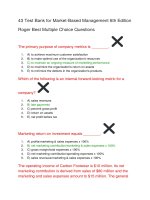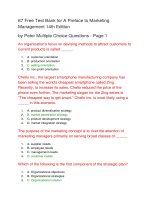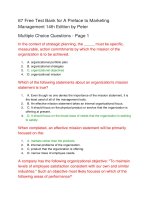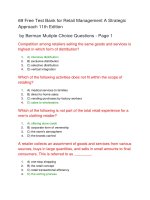Wiley series 65 exam review 2016 test bank the uniform investment advisor law examination 4th edition
Bạn đang xem bản rút gọn của tài liệu. Xem và tải ngay bản đầy đủ của tài liệu tại đây (2.84 MB, 513 trang )
WILEY FINRA SERIES
This series includes the following titles:
Wiley Series 3 Exam Review 2016 + Test Bank: National Commodities Futures
Examination
Wiley Series 4 Exam Review 2016 + Test Bank: The Registered Options Principal
Examination
Wiley Series 6 Exam Review 2016 + Test Bank: The Investment Company and
Variable Contracts Products Representative Examination
Wiley Series 7 Exam Review 2016 + Test Bank: The General Securities Representative
Examination
Wiley Series 9 Exam Review 2016 + Test Bank: The General Securities Sales
Supervisor Examination—Option Module
Wiley Series 10 Exam Review 2016 + Test Bank: The General Securities Sales
Supervisor Examination—General Module
Wiley Series 24 Exam Review 2016 + Test Bank: The General Securities Principal
Examination
Wiley Series 26 Exam Review 2016 + Test Bank: The Investment Company and
Variable Contracts Products Principal Examination
Wiley Series 55 Exam Review 2016 + Test Bank: The Equity Trader Examination
Wiley Series 62 Exam Review 2016 + Test Bank: The Corporate Securities
Representative Examination
Wiley Series 63 Exam Review 2016 + Test Bank: The Uniform Securities State Law
Examination
Wiley Series 65 Exam Review 2016 + Test Bank: The Uniform Investment Adviser
Law Examination
Wiley Series 66 Exam Review 2016 + Test Bank: The Uniform Combined State Law
Examination
Wiley Series 99 Exam Review 2016 + Test Bank: The Operations Professional
Examination
For more on this series, visit the website at www.wileysecuritieslicensing.com.
WILEY SERIES 65 EXAM REVIEW 2016
The Uniform Investment
Adviser Law Examination
The Securities Institute of America, Inc.
Cover Design: Wiley
Cover Image: © iStockphoto.com / LuisB
Copyright © 2016 by The Securities Institute of America, Inc. All rights reserved.
Published by John Wiley & Sons, Inc., Hoboken, New Jersey.
Previous editions published by The Securities Institute of America, Inc.
Published simultaneously in Canada.
No part of this publication may be reproduced, stored in a retrieval system, or transmitted in any form or by any means,
electronic, mechanical, photocopying, recording, scanning, or otherwise, except as permitted under Section 107 or 108 of
the 1976 United States Copyright Act, without either the prior written permission of the Publisher, or authorization
through payment of the appropriate per-copy fee to the Copyright Clearance Center, Inc., 222 Rosewood Drive, Danvers,
MA 01923, (978) 750-8400, fax (978) 646-8600, or on the Web at www.copyright.com. Requests to the Publisher for
permission should be addressed to the Permissions Department, John Wiley & Sons, Inc., 111 River Street, Hoboken, NJ
07030, (201) 748-6011, fax (201) 748-6008, or online at />Limit of Liability/Disclaimer of Warranty: While the publisher and author have used their best efforts in preparing this
book, they make no representations or warranties with respect to the accuracy or completeness of the contents of this
book and specifically disclaim any implied warranties of merchantability or fitness for a particular purpose. No warranty
may be created or extended by sales representatives or written sales materials. The advice and strategies contained herein
may not be suitable for your situation. Y ou should consult with a professional where appropriate. Neither the publisher
nor author shall be liable for any loss of profit or any other commercial damages, including but not limited to special,
incidental, consequential, or other damages.
For general information on our other products and services or for technical support, please contact our Customer Care
Department within the United States at (800) 762-2974, outside the United States at (317) 572-3993 or fax (317) 5724002.
Wiley publishes in a variety of print and electronic formats and by print-on-demand. Some material included with
standard print versions of this book may not be included in e-books or in print-on-demand. If this book refers to media
such as a CD or DVD that is not included in the version you purchased, you may download this material at
. For more information about Wiley products, visit www.wiley.com.
ISBN 9781119112396 (Paperback)
ISBN 9781119138846 (ePDF)
ISBN 9781119138822 (ePub)
CONTENTS
About the Series 65 Exam
Taking the Series 65 Exam
How to Prepare for the Series 65 Exam?
Why Do I Need to Take the Series 65 Exam?
What Score Is Needed to Pass the Exam?
Are There Any Prerequisites for the Series 65 Exam?
How Do I Schedule an Exam?
What Must I Take to the Exam Center?
How Soon Will I Receive the Results of the Exam?
About This Book
About the Test Bank
About The Securities Institute of America
Chapter 1: Equity Securities
What Is a Security?
Equity = Stock
Common Stock
Corporate Time Line
Values of Common Stock
Book Value
Par Value
Rights of Common Stockholders
Preemptive Rights
Characteristics of a Rights Offering
Determining the Value of a Right Cum Rights
Determining the Value of a Right Ex Rights
Voting
Limited Liability
Freely Transferable
The Transfer Agent
The Registrar
CUSIP Numbers
Inspection of Books and Records
Residual Claim to Assets
Why Do People Buy Common Stock?
Income
What Are the Risks of Owning Common Stock?
How Does Someone Become a Stockholder?
Preferred Stock
Features of All Preferred Stock
Types of Preferred Stock
Callable Preferred
Types of Dividends
Dividend Distribution
Taxation of Dividends
Selling Dividends
Dividend Disbursement Process
Warrants
How Do People Get Warrants?
American DepositAry Receipts (ADRs)/American DepositAry Shares (ADSs)
Currency Risks
Functions of the Custodian Bank Issuing ADRs
Real Estate Investment Trusts/REITs
Direct Participation Programs and Limited Partnerships
Limited Partnerships
Tax Reporting for Direct Participation Programs
Limited Partnership Analysis
Tax Deductions vs. Tax Credits
Other Tax Considerations
Dissolving a Partnership
Pretest
Chapter 2: Corporate and Municipal Debt Securities
Corporate Bonds
Types of Bond Issuance
Bond Pricing
Par Value
Discount
Premium
Corporate Bond Pricing
Bond Yields
Yield to Maturity: Premium Bond
Yield to Maturity: Discount Bond
Calculating the Yield to Maturity
Calculating the Yield to Call
Realized Compound Yield Returns
Yield Spreads
The Real Interest Rate
Bond Maturities
Series Issue
Types of Corporate Bonds
Guaranteed Bonds
Convertible Bonds
Converting Bonds into Common Stock
Parity Price
Advantages of Issuing Convertible Bonds
Disadvantages of Issuing Convertible Bonds
Convertible Bonds and Stock Splits
The Trust Indenture Act of 1939
Bond Indenture
Ratings Considerations
Exchange Traded Notes (ETNs)
Euro and Yankee Bonds
Variable Rate Securities
Retiring Corporate Bonds
Municipal Bonds
Types of Municipal Bonds
Taxation of Municipal Bonds
Tax-Equivalent Yield
Purchasing a Municipal Bond Issued in the State in Which the Investor Resides
Triple Tax Free
Original Issue Discount (OID) and Secondary Market Discounts
Amortization of a Municipal Bond's Premium
Bond Swaps
Analyzing Municipal Bonds
Analyzing General Obligation Bonds
Duration
Convexity
Bond Portfolio Management
Pretest
Chapter 3: Government and Government Agency Issues
Series EE Bonds
Series HH Bonds
Treasury Bills, Notes, and Bonds
Purchasing Treasury Bills
Treasury Notes
Treasury Bonds
Treasury Bond and Note Pricing
Treasury STRIPs
Treasury Receipts
Treasury Inflation Protected Securities (TIPS)
Agency Issues
Government National Mortgage Association (GNMA)
Federal National Mortgage Association (FNM)
Federal Home Loan Mortgage Corporation (FHLMC)
Federal Farm Credit System
Collateralized Mortgage Obligation (CMO)
CMOs and Interest Rates
Types of CMOs
Pretest
Chapter 4: Investment Companies
Investment Company Philosophy
Types of Investment Companies
Open End vs. Closed End
Diversified vs. Nondiversified
Investment Company Registration
Registration Requirements
Investment Company Components
Mutual Fund Distribution
Selling Group Member
Distribution of No-Load Mutual Fund Shares
Distribution of Mutual Fund Shares
Mutual Fund Prospectus
Characteristics of Open-End Mutual Fund Shares
Mutual Fund Investment Objectives
Other Types of Funds
Bond Funds
Alternative Funds
Valuing Mutual Fund Shares
Sales Charges
Other Types of Sales Charges
Recommending Mutual Funds
Calculating a Mutual Fund's Sales Charge Percentage
Finding the Public Offering Price
Sales Charge Reductions
Breakpoint Schedule
Letter of Intent
Breakpoint Sales
Rights of Accumulation
Automatic Reinvestment of Distributions
Other Mutual Fund Features
Dollar Cost Averaging
Mutual FUnds Voting Rights
Mutual Fund Yields
Portfolio Turnover
Pretest
Chapter 5: Variable Annuities and Retirement Plans
Annuities
Bonus Annuity
Equity-Indexed Annuity
Recommending Variable annuities
Annuity Purchase Options
Accumulation Units
Annuity Units
Annuity Payout Options
Factors Affecting the Size of the Annuity Payment
The Assumed Interest Rate (AIR)
Taxation
Types of Withdrawals
Annuitizing the Contract
Sales Charges
Investment Management Fees
Variable Annuity vs. Mutual Fund
Retirement Plans
Individual Plans
Individual Retirement Accounts (IRAs)
Corporate Plans
Types of Plans
Rolling Over a Pension Plan
Employee Stock Options
Employee Retirement Income Security Act of 1974 (ERISA)
ERISA 404C SAFE HARBOR
Life Insurance
Tax Implications of Life Insurance
Pretest
Chapter 6: Fundamental and Technical Analysis
Fundamental Analysis
Balance Sheet
Capitalization
Changes in the Balance Sheet
The Income Statement
Industry Fundamentals
Top-Down and BOTTOM-UP Analysis
Dividend Valuation Models
Technical Analysis
Market Theories and Indicators
Efficient Market Theory
Statistical Analysis
Market Capitalization
Pretest
Chapter 7: Economic Fundamentals
Gross Domestic Product
Recession
Depression
Economic Indicators
Schools of Economic Thought
Economic Policy
Tools of the Federal Reserve Board
INTEREST RATES
Reserve Requirement
Changing the Discount Rate
Federal Open Market Committee
Money Supply
Disintermediation
Moral Suasion
Fiscal Policy
International Monetary Considerations
London Interbank Offered Rate / LIBOR
Yield Curve Analysis
Pretest
Chapter 8: Recommendations, Professional Conduct, and Taxation
Professional Conduct by Investment Advisers
The Uniform Prudent Investors Act of 1994
Fair Dealings with Clients
Recommending Mutual Funds
Periodic Payment Plans
Disclosure of Client Information
Borrowing and Lending Money
Developing the Client Profile
Types of Advisory Clients
Investment Objectives
Capital Asset Pricing Model (CAPM)
Risk vs. Reward
Alpha
Beta
Expected Return
Time Value of Money
Weighted Returns
Modern Portfolio Theory
Predicting Portfolio Income
Tax Structure
Investment Taxation
Calculating Gains and Losses
Cost Base of Multiple Purchases
Deducting Capital Losses
Wash Sales
Taxation of Interest Income
Inherited and Gifted Securities
Donating Securities to Charity
Trusts
Gift Taxes
Estate Taxes
Withholding Tax
Corporate Dividend Exclusion
Alternative Minimum Tax (AMT)
Taxes on Foreign Securities
Pretest
Chapter 9: Securities Industry Rules and Regulations
The Securities Act of 1933
The Prospectus
The Final Prospectus
SEC Disclaimer
Misrepresentations
The Securities Exchange Act of 1934
The Securities Exchange Commission (SEC)
Extension of Credit
Public Utilities Holding Company Act of 1935
Financial Industry Regulatory Authority (FINRA)
The Trust Indenture Act of 1939
Investment Advisers Act of 1940
Investment Company Act of 1940
FINRA Member Communications with the Public
FINRA Rule 2210 Communications with the Public
Corporate Websites
Blind Recruiting Ads
Generic Advertising
Tombstone Ads
Testimonials
Free Services
Misleading Communications
Securities Investor Protection Corporation Act of 1970 (SIPC)
Net Capital Requirement
Customer Coverage
Fidelity Bond
The Securities Acts Amendments of 1975
The Insider Trading and Securities Fraud Enforcement Act of 1988
Firewall
The Telephone Consumer Protection Act of 1991
Exemption from the Telephone Consumer Protection Act of 1991
National Securities Market Improvement Act of 1996
The Uniform Securities Act
Currency Transactions
The Patriot Act
Pretest
Chapter 10: Trading Securities
Types of Orders
The Exchanges
Priority of Exchange Orders
The Role of the Specialist/DMM
The Specialist/DMM Acting as a Principal
The Specialist/DMM Acting as an Agent
Crossing Stock
Do Not Reduce (DNR)
Adjustments for Stock Splits
Stopping Stock
Commission House Broker
Two-Dollar Broker
Registered Traders
Super Display Book (SDBK)
Short Sales
Regulation of Short Sales/Regulation SHO
Rule 200 Definitions and Order Marking
Rule 203 Security Borrowing and Delivery Requirements
Over the Counter/Nasdaq
Market Makers
Nasdaq Subscription Levels
Nasdaq Quotes
Nominal Nasdaq Quotes
Nasdaq Execution Systems
Nasdaq Market Center Execution System (NMCES)
Nasdaq Opening Cross
Non-Nasdaq OTCBB
Pink OTC
Third Market
Fourth Market
Broker vs. Dealer
FINRA 5% Markup Policy
Markups/Markdowns when Acting as a Principal
Riskless Principal Transactions
Proceeds Transactions
Arbitrage
Pretest
Chapter 11: Options
Option Classification
Option Classes
Option Series
Bullish vs. Bearish
Possible Outcomes for an Option
Characteristics of All Options
Managing an Option Position
Buying Calls
Maximum Gain Long Calls
Maximum Loss Long Calls
Determining the Breakeven for Long Calls
Selling Calls
Buying Puts
Selling Puts
Option Premiums
In-the-Money Options
At-the-Money Options
Out-of-the-Money Options
Intrinsic Value and Time Value
Using Options as a Hedge
Long Stock Long Puts/Married Puts
Long Stock Short Calls/Covered Calls
Short Stock Long Calls
Short Stock Short Puts
Futures and Forwards
Correlation
Pretest
Chapter 12: Definition of Terms
Security
Person
Broker Dealer
Agent
Issuer
Nonissuer
Investment Adviser
Pension Consultants
Investment Counsel
Form ADV
Investment Adviser Registration Database IARD
Investment Adviser Representative
Solicitor
Access Person
Institutional Investor
Accredited Investor
Qualified Purchaser
Private Investment Company
Offer/Offer to Sell/Offer to Buy
Sale/Sell
Guarantee/Guaranteed
Contumacy
Federally Covered Exemption
Power of attorney
Negotiable Certificate of Deposit
Pretest
Chapter 13: Registration of Broker Dealers, Investment Advisers, and Agents
Registration of Broker Dealers and Agents
changes in an Agent's Employment
Mergers and Acquisitions of Firms
Renewing Registrations
Canadian Firms and Agents
Investment Adviser Registration
Advertising and Sales Literature
Brochure Delivery
The Role of the Investment Adviser
Additional Compensation for an Investment Adviser
Agency Cross Transactions
Disclosures by an Investment Adviser
Investment Adviser Contracts
Additional Roles of Investment Advisers
Private Investment Companies/Hedge Funds
Fulcrum Fees
Wrap Accounts
Soft Dollars
Pretest
Chapter 14: Securities Registration, Exempt Securities, and Exempt Transactions
Exempt Securities
Securities Registration
Exempt Securities/Federally Covered Exemption
Exempt Transactions
Private Placements/Regulation D Offerings
RULE 144
RULE 147 Intrastate Offering
Transactions with Financial Institutions
Transactions with Fiduciaries
Transactions with Underwriters
Unsolicited Orders
Transactions in Mortgage-Backed Securities
Pledges
Offers to Existing Securities Holders
Preorganization Certificates
Isolated Nonissuer Transactions
Nonissuer Transactions
Pretest
Chapter 15: State Securities Administrator: The Uniform Securities Act
North America Securities Administrators Association
Actions by the State Securities Administrator
Cancelation of a Registration
Withdrawal of a Registration
Actions Against an Issuer of Securities
Rule Changes
Administrative Orders
Interpretive Opinions
Administrative Records
Investigations
Civil and Criminal Penalties
Jurisdiction of the State Securities Administrator
Administrator's Jurisdiction over Securities Transactions
Radio, Television, and Newspaper Distribution
Right of Rescission
Statute of Limitations
Pretest
Answer Keys
Chapter 1: Equity Securities
Chapter 2: Corporate and Municipal Debt Securities
Chapter 3: Government and Government Agency Issues
Chapter 4: Investment Companies
Chapter 5: Variable Annuities and Retirement Plans
Chapter 6: Fundamental and Technical Analysis
Chapter 7: Economic Fundamentals
Chapter 8: Recommendations, Professional Conduct, and Taxation
Chapter 9: Securities Industry Rules and Regulations
Chapter 10: Trading Securities
Chapter 11: Options
Chapter 12: Definition of Terms
Chapter 13: Registration of Broker Dealers, Investment Advisers, and Agents
Chapter 14: Securities Registration, Exempt Securities, and Exempt Transactions
Chapter 15: State Securities Administrator: The Uniform Securities Act
Glossary of Exam Terms
Index
Advert
Access Code
EULA
About the Series 65 Exam
Congratulations! You are on your way to becoming licensed as an investment adviser in
all states that require the Series 65 license. The Series 65 exam will be presented in a 130question multiple-choice format. Each candidate will have three hours to complete the
exam. A score of 72% or higher is required to pass.
The Series 65 is as much a knowledge test as it is a reading test. The writers and
instructors at The Securities Institute have developed the Series 65 textbook, exam prep
software, and videos to ensure that you have the knowledge required to pass the test, and
to make sure that you are confident in the application of the knowledge during the exam.
The writers and instructors at The Securities Institute are subject-matter experts as well
as Series 65 test experts. We understand how the test is written and our proven testtaking techniques can dramatically improve your results.
Taking the Series 65 Exam
The Series 65 exam is presented in multiple-choice format on a touch-screen computer
known as the PROCTOR system. No computer skills are required and candidates will find
that the test screen works in the same way as an ordinary ATM machine. Each test is
made up of 130 questions that are randomly chosen from a test bank of several thousand
questions. The test has a time limit of three hours and is designed to provide enough time
for all candidates to complete the exam. Each Series 65 exam will have 10 additional
questions that do not count toward the final score. The Series 65 exam comprises
questions that focus on the following areas:
Ethics and legal guidelines 40 questions
31%
Investment strategies
40 questions
31%
Investment vehicles
31 questions
24%
Economics and analysis
19 questions
14%
TOTAL
130 Questions 100%
How to Prepare for the Series 65 Exam?
For most candidates the combination of reading the textbook, watching the videos, and
using the exam prep software is enough to successfully complete the exam. It is
recommended that the individual spend at least 40 hours preparing for the exam by
reading the textbook, underlining key points, watching the video class, and by taking as
many practice questions as possible. We recommend that a student schedule his or her
exam no more than one week after completing the Series 65 exam prep.
Test-Taking Tips
Read the full question before answering.
Identify what the question is asking.
Identify key words and phrases.
Watch out for hedge clauses, for example, except and not.
Eliminate wrong roman numeral answers.
Identify synonymous terms.
Be wary of changing answers.
Why Do I Need to Take the Series 65 Exam?
In order to conduct fee-based securities business, most states require that an agent
successfully complete the Series 65 exam. Passing the Series 65 exam will allow an agent
to receive asset-based management and other advisory fees. The Series 65 is often taken
in addition to obtaining a Series 6, 7, or 62 registration, which allow an agent to receive
transaction-based compensation.
What Score Is Needed to Pass the Exam?
A score of 72% or higher is needed to pass the Series 65 exam.
Are There Any Prerequisites for the Series 65 Exam?
A candidate is not required to have any other professional qualifications prior to taking
the Series 65 exam.
How Do I Schedule an Exam?
Ask your firm's principal to schedule the exam for you, or for a list of test centers in your
area. You may be self-sponsored to take the exam. You must fill out and submit form U10
prior to making an appointment. The Series 65 exam may be taken any day that the exam
center is open.
What Must I Take to the Exam Center?
A picture ID is required. All other materials will be provided, including a calculator and
scratch paper.
How Soon Will I Receive the Results of the Exam?
The exam will be graded as soon as you answer your final question and hit the Submit for
Grading button. It will take only a few minutes to get your results. Your grade will appear
on the computer screen and you will be given a paper copy from the exam center.
If you do not pass the test, you will need to wait 30 days before taking it again. If you do
not pass on the second try, you'll need to wait another 30 days. After that, you are
required to wait 6 months to take the test again.
About This Book
The writers and instructors at The Securities Institute have developed the Series 65
textbook, exam prep software, and videos to ensure that you have the knowledge required
to pass the test, and to make sure that you are confident in the application of that
knowledge during the exam. The writers and instructors at The Securities Institute are
subject matter experts as well as Series 65 test experts. We understand how the test is
written and our proven test-taking techniques can dramatically improve your results.
Each chapter includes notes, tips, examples, and case studies with key information, hints
for taking the exam, and additional insight into the topics. Each chapter ends with a
practice test, to ensure you have mastered the concepts before moving on to the next
topic.
About the Test Bank
This book is accompanied by a test bank of more than 350 questions to further reinforce
the concepts and information presented here. The access card in the back of this book
includes the URL and PIN code you can use to access the test bank. This test bank
provides a small sample of the questions and features that are contained in the full
version of the Series 65 exam prep software.
If you have not purchased the full version of the exam prep software with this book, we
highly recommend it to ensure that you have mastered the knowledge required for your
Series 65 exam. To purchase the exam prep software for this exam, visit The Securities
Institute of America online at www.SecuritiesCE.com or call 877-1776.
About The Securities Institute of America
The Securities Institute of America, Inc. helps thousands of securities and insurance
professionals build successful careers in the financial services industry every year.
Our securities training options include:
On-site training classes
Private tutoring
Classroom training
Interactive online video training classes
State-of-the-art exam-preparation software
Printed textbooks
Real-time tracking and reporting for managers and training directors
You can choose a securities training solution that matches your skill level, learning style,
and schedule. Regardless of the format you choose, you can be sure that our securities
training courses are relevant, tested, and designed to help you succeed. It is the
experience of our instructors and the quality of our materials that make our courses
requested by name at some of the largest financial services firms in the world.
To contact The Securities Institute of America, visit us on the Web at
www.SecuritiesCE.com or call 877-218-1776.
About the Series 65 Exam
CHAPTER 1
Equity Securities
INTRODUCTION
This first chapter will build the foundation upon which the rest of this text is built. A
thorough understanding of equity securities will be necessary in order to successfully
complete the Series 65 exam. Equity securities are divided into two types: common
and preferred stock. We will examine the features of common stock and preferred
stock, as well as the benefits and risks associated with their ownership, but first we
must define exactly what meets the definition of a security.
What Is a Security?
A security is any investment product that can be exchanged for value and involves risk. In
order for an investment to be considered a security, it must be readily transferable
between two parties and the owner must be subject to the loss of some, or all, of the
invested principal. If the product is not transferable or does not contain risk, it is not a
security.
Types of Securities
Types of Nonsecurities
Common stock
Whole life insurance
Preferred stock
Term life insurance
Bonds
IRAs
Mutual funds
Retirement plans
Variable annuities
Fixed annuities
Variable life insurance
Prospectus
Options
Confirmations
Rights
Warrants
ETFs/ETNs
Real estate investment trusts
CMOs
Equity = Stock
The term equity is synonymous with the term stock. Throughout your preparation for this









